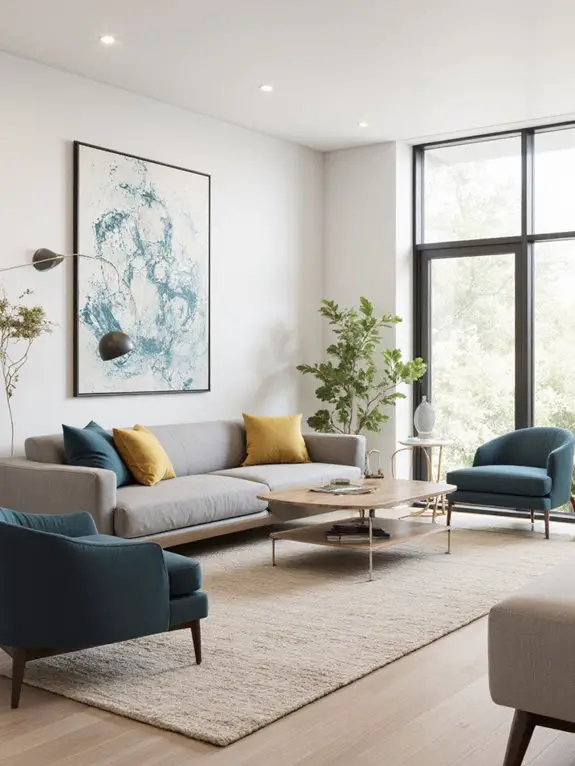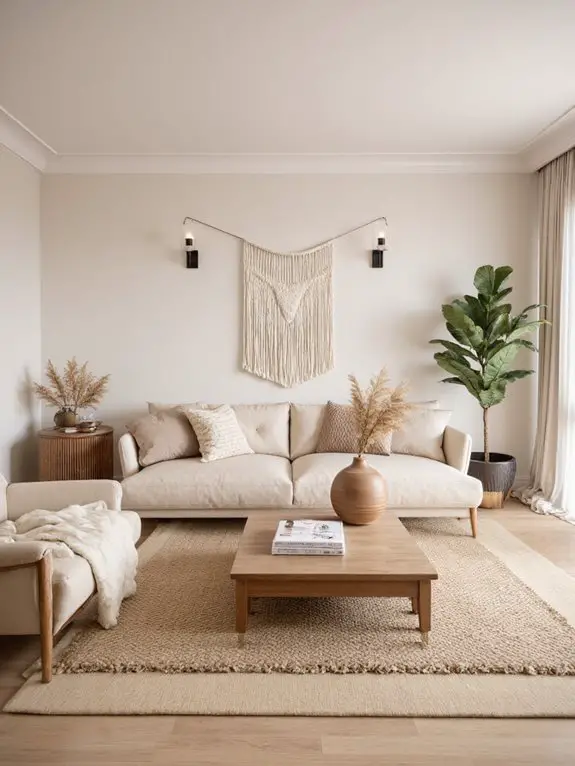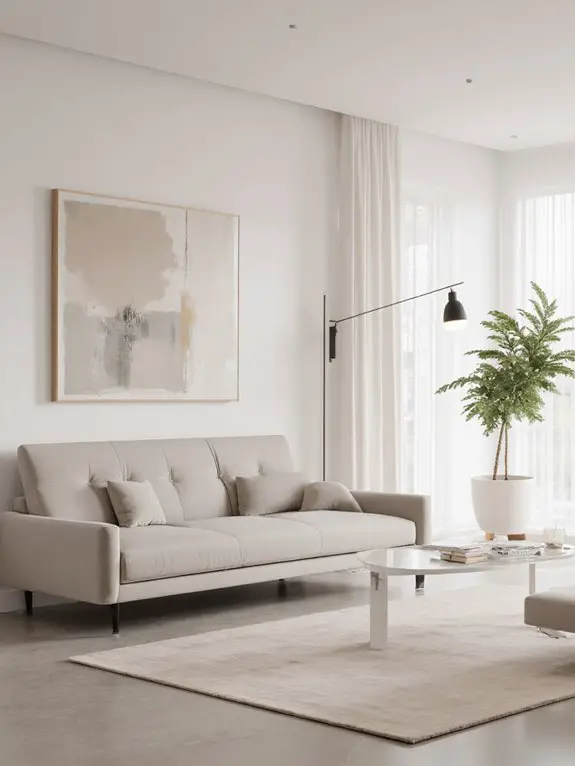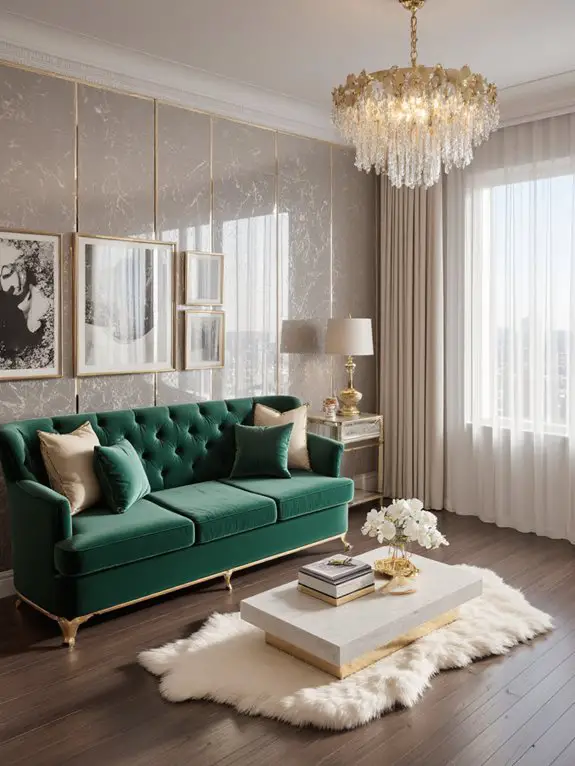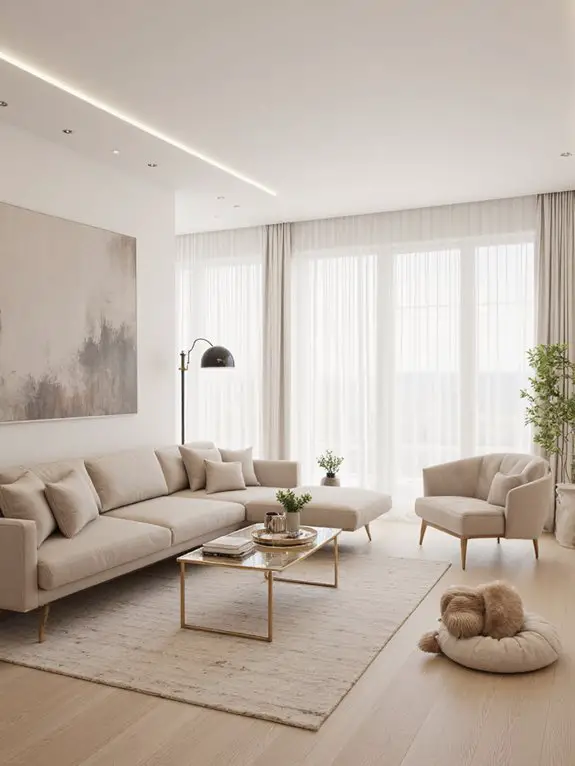I recommend starting with a minimalist Scandinavian-inspired design for a sleek, functional living area. Incorporate rustic farmhouse wood accents or bold color schemes to add personality and warmth. Layering textures in a boho chic style or adding metallic touches for a modern look can elevate the space. Smart storage solutions and warm lighting guarantee a cozy, clutter-free ambiance. Seasonal updates keep the room fresh year-round—there’s more to explore for a truly transformed space.
Minimalist Scandinavian-Inspired Living Room
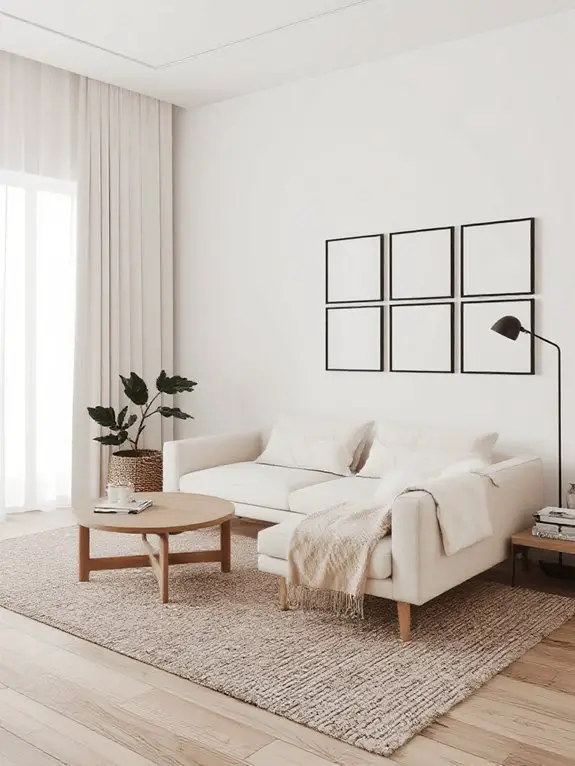
Although designing a minimalist Scandinavian-inspired living room may seem intimidating, it’s easier than you’d think once you focus on simplicity and functionality. I start by choosing a neutral color palette—whites, grays, and soft pastels—to create a calming atmosphere.
Natural light is key, so I keep window treatments minimal or sheer. When selecting furniture, I opt for sleek, functional pieces with clean lines, like a streamlined sofa and a low-profile coffee table.
I add warmth with textured rugs and a few potted plants. Storage is essential to maintain clutter-free spaces, so I incorporate stylish baskets or hidden organizers.
Less truly is more here.
Rustic Farmhouse Style With Wood Accents
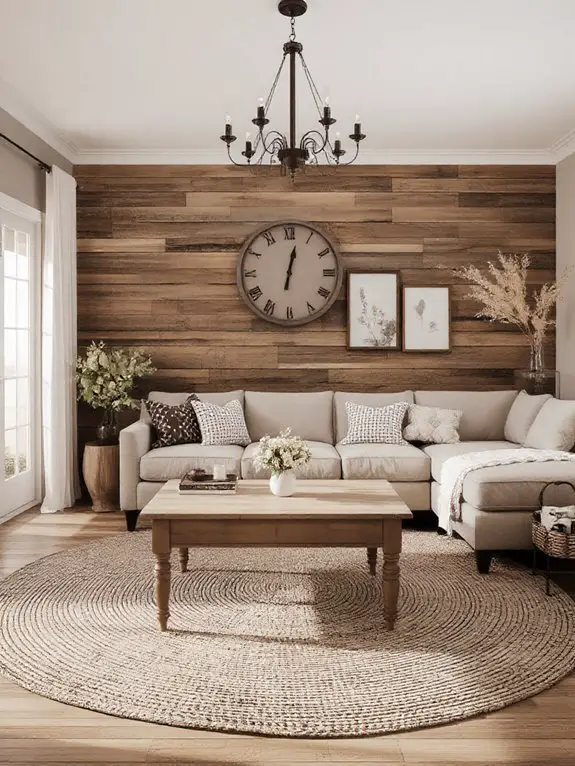
When aiming to create a rustic farmhouse-style living area, I begin by embracing natural wood as the foundation of the design. I opt for reclaimed wood beams or a wide-plank hardwood floor to establish a warm, earthy feel.
Adding a distressed wood coffee table or a barnwood accent wall enhances the character without overwhelming the space. I balance the ruggedness with soft furnishings—linen cushions, knit throws, and neutral-toned rugs—to create comfort.
Incorporating vintage-inspired lighting, like wrought iron chandeliers, ties everything together. The goal is to evoke charm and simplicity, keeping the space inviting yet authentically rustic.
Bold Color Schemes for Maximum Impact
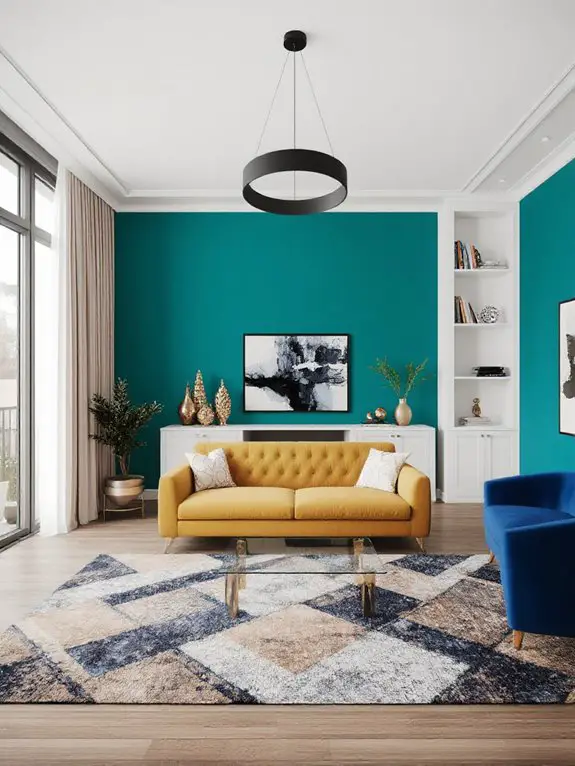
Choosing bold colors for a living area can instantly transform a space from muted to dynamic, creating a striking focal point that energizes the entire room. I love experimenting with deep emerald greens, rich navy blues, or fiery oranges paired with neutral tones to balance the intensity.
A feature wall in a bold hue draws the eye, while colorful furniture or accessories add pops of personality. I always consider natural light—dark shades work best in sunlit rooms, while bright tones amplify cozier spaces.
Bold doesn’t mean overwhelming; it’s about careful curation that makes a statement while maintaining harmony.
Cozy Boho Chic With Textured Layers
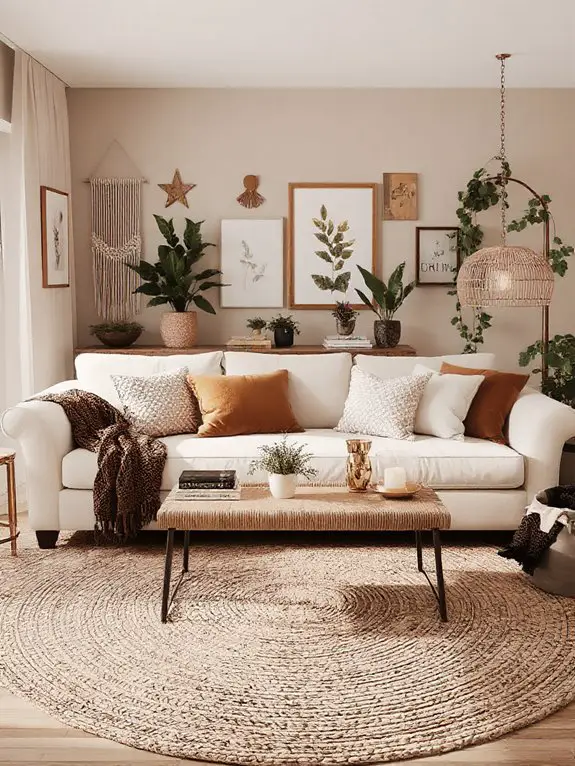
Creating a cozy boho chic living area starts with layering textures to achieve depth and warmth. I love mixing plush rugs, woven throws, and embroidered cushions for a tactile experience. Incorporate natural fabrics like cotton, linen, and jute to enhance the organic vibe.
Don’t shy away from macramé wall hangings or rattan furniture—they add character and charm. Layering different patterns, like florals and geometrics, can create visual interest without overwhelming the space.
Warm, earthy tones paired with pops of color keep it balanced. Finally, scatter candles, poufs, and plants around to make the room feel lived-in and inviting.
Sleek Modern Design With Metallic Touches
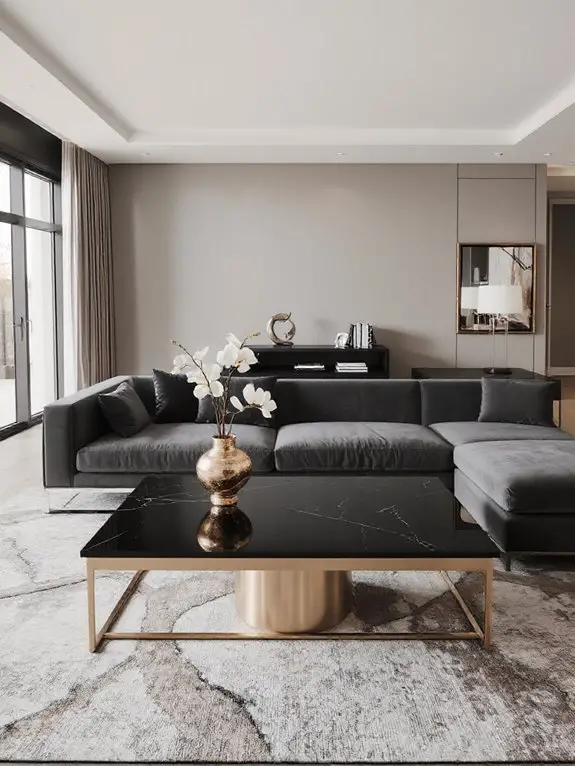
To achieve a sleek modern design with metallic touches, I focus on clean lines and a minimalist aesthetic while incorporating shimmering accents for sophistication. I start with a neutral color palette—whites, grays, or blacks—and layer in metallic finishes like chrome, brushed nickel, or gold.
A statement piece, like a geometric coffee table or metallic-framed mirror, becomes the focal point. I opt for sleek, low-profile furniture with polished surfaces to maintain the streamlined look.
Subtle metallic details in lighting fixtures, throw pillows, or decor accessories add depth without overwhelming. The goal is balance: modern elegance with just enough shine to captivate.
Small-Space Solutions for Compact Rooms
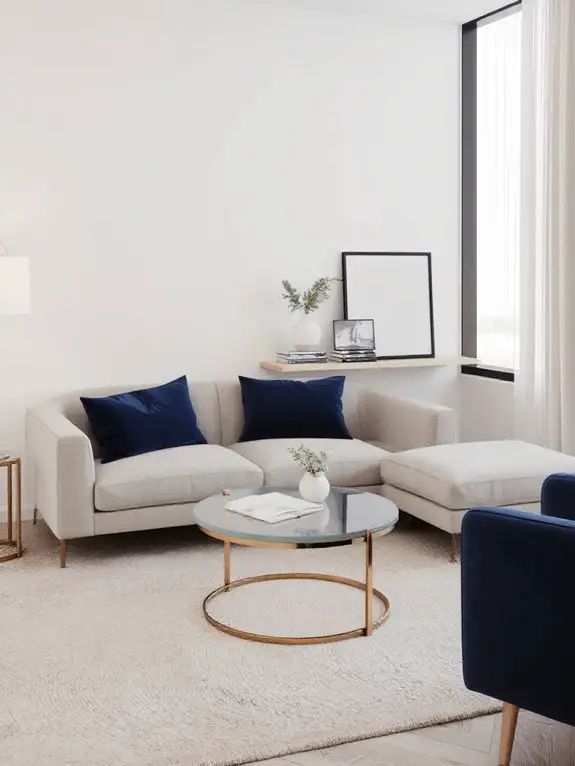
While small spaces can feel challenging to design, I’ve found that strategic planning maximizes both functionality and style. Start by choosing multi-functional furniture, like a sofa bed or nesting tables, to save floor space. Vertical storage—floating shelves or tall bookcases—draws the eye up, making rooms feel larger.
Mirrors reflect light and create depth, while light-colored walls enhance brightness. Avoid bulky pieces; opt for sleek, leggy furniture to maintain an airy feel. Keep clutter minimal with hidden storage, like ottomans with compartments.
Finally, define zones with rugs or lighting to organize the space without walls. Small rooms can shine with smart choices.
Open Floor Plan Layout Tips
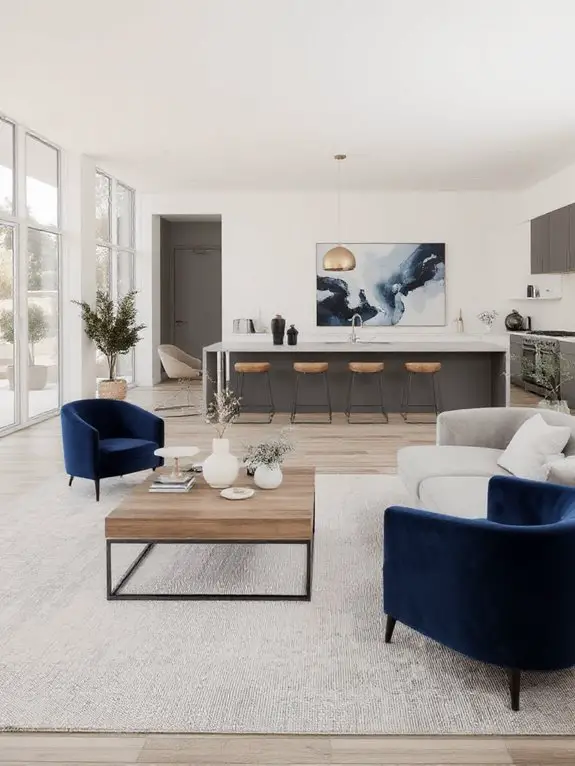
Although open floor plans can seem intimidating to design, I’ve discovered that thoughtful arrangement can turn them into cohesive, functional spaces. Start by defining zones with furniture placement—use a sofa to separate the living area from the dining space or a rug to anchor a seating group.
Keep the flow natural by leaving pathways clear and avoiding clutter. Consistency in color palettes and materials ties the space together, preventing it from feeling disjointed.
I also recommend balancing scale—don’t overwhelm the area with oversized pieces or make it feel sparse with tiny furniture. Thoughtful planning guarantees harmony and practicality.
Statement Lighting as a Focal Point
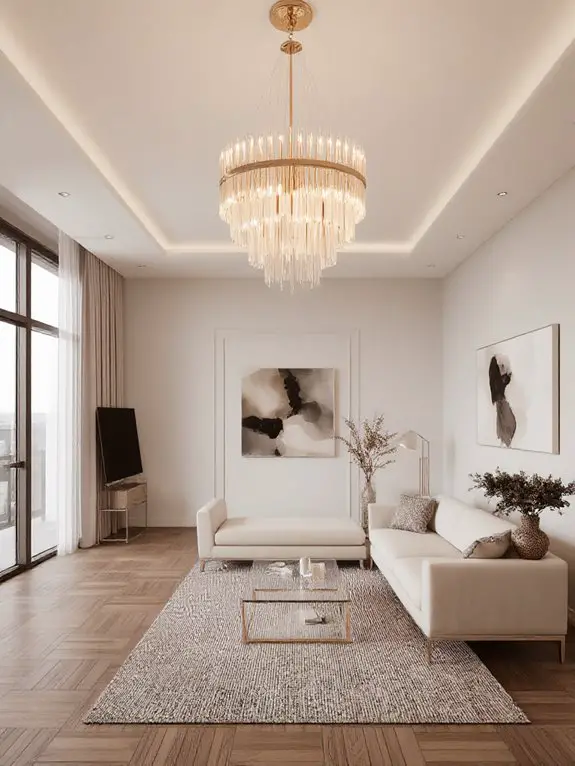
Statement lighting transforms a room by anchoring the design and setting the tone—it’s not just functional but a key element of your space’s personality. I always start by choosing a piece that complements the room’s scale and style, like a bold chandelier or sculptural pendant.
Positioning matters; hang it lower than you might think to create intimacy or higher to emphasize height. I prefer warm bulbs to soften the ambiance, avoiding harsh, cool tones.
Don’t shy away from unique shapes or materials—they can spark conversation and elevate the entire space. Remember, statement lighting isn’t just about brightness; it’s about making a lasting impression.
Mixing Vintage and Contemporary Furniture
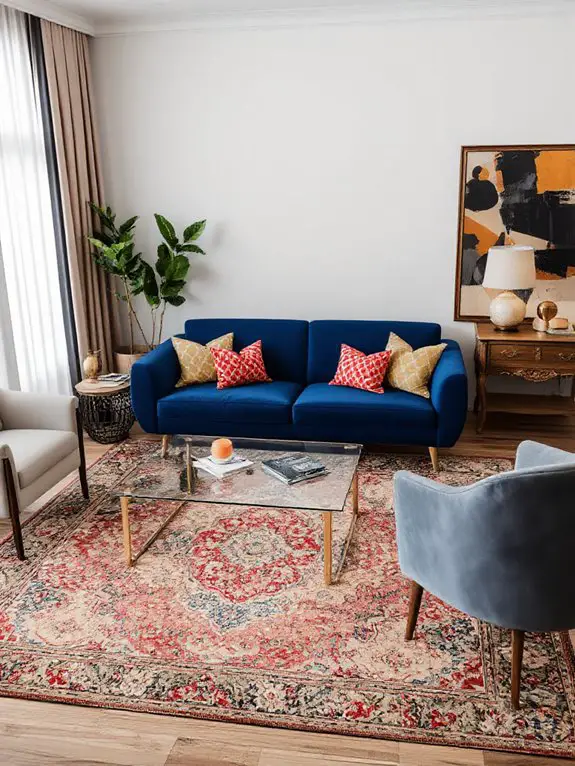
Blending vintage and contemporary furniture creates a dynamic and layered look that feels both timeless and fresh. I like to start by choosing a dominant style—either vintage or modern—then introduce a few contrasting pieces to create balance.
For example, pairing a sleek, contemporary sofa with a rustic wooden coffee table adds warmth and character. I also focus on unifying elements, like a consistent color palette or coordinating materials, to tie the look together.
Don’t shy away from mixing textures and finishes; they add depth. The key is to curate intentionally, ensuring each piece complements the overall aesthetic without overwhelming the space.
Gallery Wall Ideas for Personality
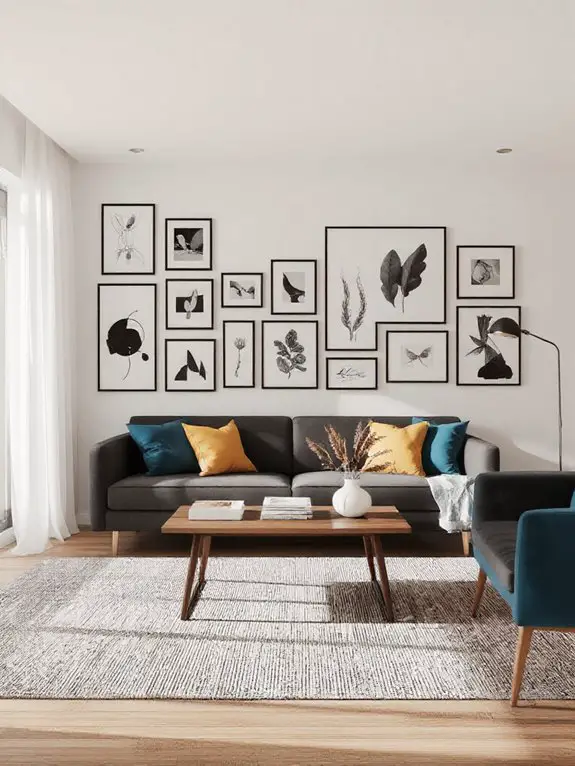
With a carefully curated gallery wall, you can infuse your living space with a sense of personality and individuality that reflects your unique tastes. Start by selecting a mix of artworks, photographs, and prints that resonate with you—think family snapshots, travel mementos, or bold abstract pieces.
Experiment with layouts by arranging frames on the floor before hanging them. Vary frame styles and sizes for visual interest, but stick to a cohesive color palette to tie it all together.
Don’t shy away from adding unconventional elements like mirrors, textiles, or sculptural accents to elevate the display and make it truly your own.
Luxe Velvet and Marble Accents
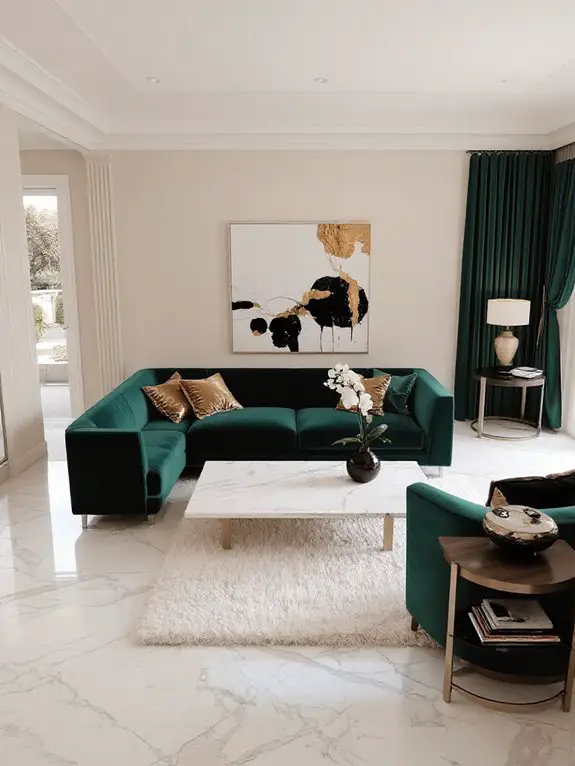
When you’re aiming to create a sophisticated yet inviting living area, combining luxe velvet and marble accents can instantly elevate the space. I always recommend starting with a plush velvet sofa in a deep jewel tone like emerald or sapphire—its texture adds warmth and richness.
Pair it with a sleek marble coffee table or side tables to introduce a touch of elegance and contrast. Marble’s natural veining brings a unique, upscale aesthetic, while its cool surface balances the softness of velvet.
Don’t forget smaller accents, like velvet throw pillows or a marble tray, to tie the look together seamlessly.
Monochromatic Themes for Sophistication
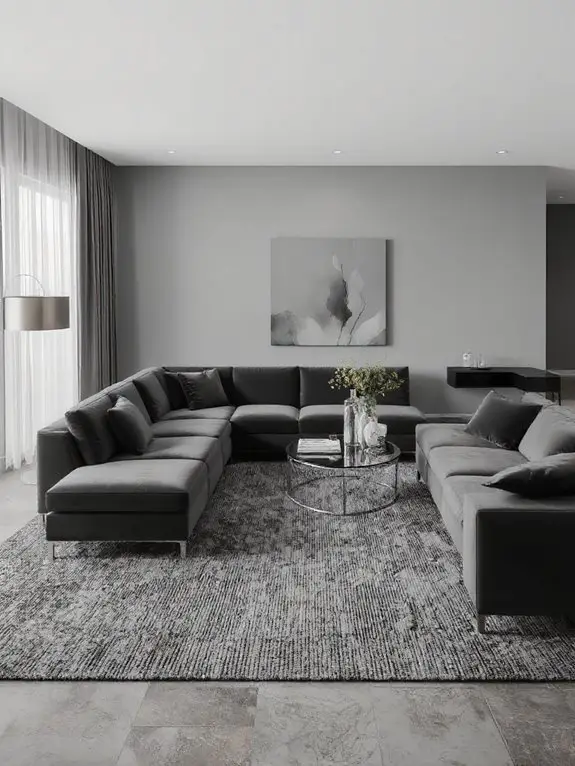
A monochromatic theme can transform a living area into a cohesive and sophisticated haven, effortlessly exuding calm and elegance. I’ve found that sticking to one color family creates a seamless flow, making the space feel larger and more intentional.
To avoid monotony, I layer varying textures—like a plush rug, matte walls, and glossy accents—to add depth and interest. Incorporating subtle tonal shifts, such as mixing lighter and darker shades, enhances the design’s complexity.
I also recommend using metallics or natural wood tones as neutrals to anchor the scheme. This approach guarantees a polished, timeless aesthetic that’s both serene and visually striking.
Incorporating Indoor Plants for Freshness
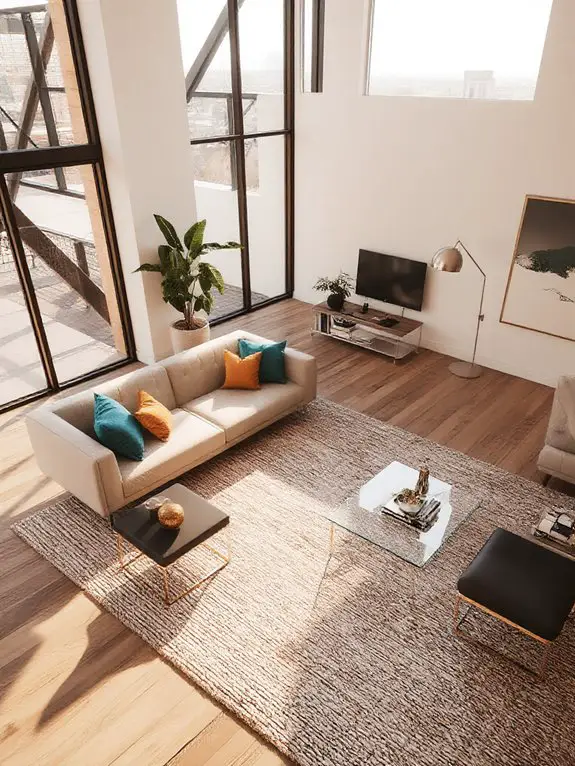
To bring a gust of revitalizing energy into your living space, I’ve discovered that incorporating indoor plants is a simple yet transformative strategy. Start by choosing low-maintenance varieties like pothos or snake plants, ideal for beginners.
Place them in areas with natural light, such as near windows or on shelves, to enhance their growth and vibrancy. Use a mix of plant sizes—larger floor plants for focal points and smaller ones for tabletops.
Don’t forget stylish pots that complement your decor. Plants not only purify the air but also add texture, color, and a calming atmosphere to your living area.
Eclectic Decor With Global Influences
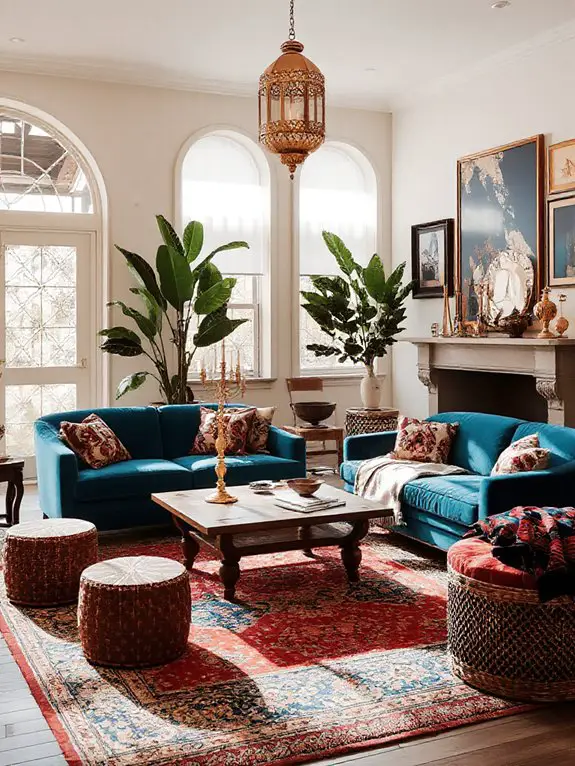
While blending global influences into your decor might seem overwhelming, it’s an exciting way to create a space that feels uniquely yours. Start by selecting a few key pieces from different cultures, like a Moroccan rug, a Japanese shoji screen, or Indian throw pillows.
Mix textures and patterns thoughtfully—let bold prints coexist with muted tones to balance the look. Incorporate handcrafted items like pottery or woven baskets to add authenticity.
Don’t be afraid to layer, but keep cohesion by sticking to a unified color scheme. This approach lets you celebrate global artistry while crafting a space that’s both personal and dynamic.
Neutral Palettes for Timeless Appeal
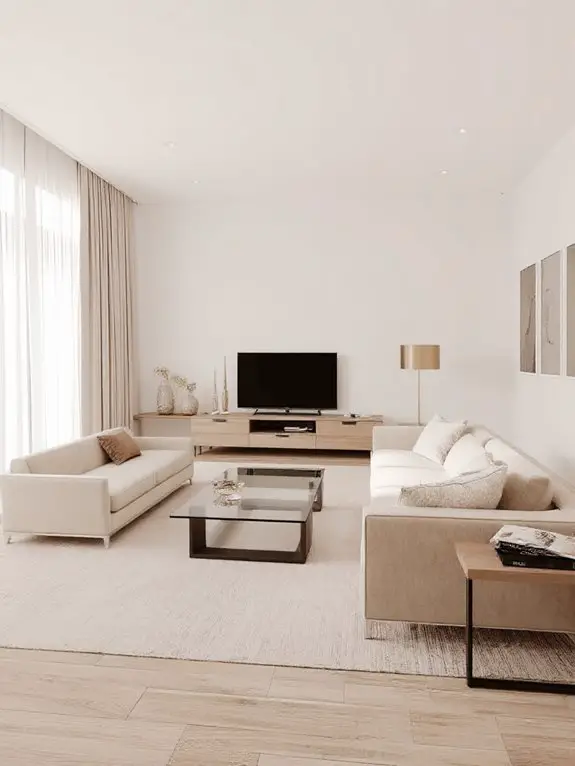
Neutral palettes offer a versatile foundation for creating spaces that feel both elegant and enduring. I’ve found that shades like beige, gray, and cream provide a calm backdrop, allowing furniture and decor to shine without overwhelming the eye.
Layering textures, such as a plush rug or linen curtains, adds depth and warmth to the room. I recommend incorporating subtle accent pieces in muted tones to maintain cohesion while adding visual interest.
Neutral colors also adapt effortlessly to changing trends, making them a practical choice for long-term design. With thoughtful touches, a neutral palette creates a serene, timeless living area.
Creative Use of Mirrors to Expand Space
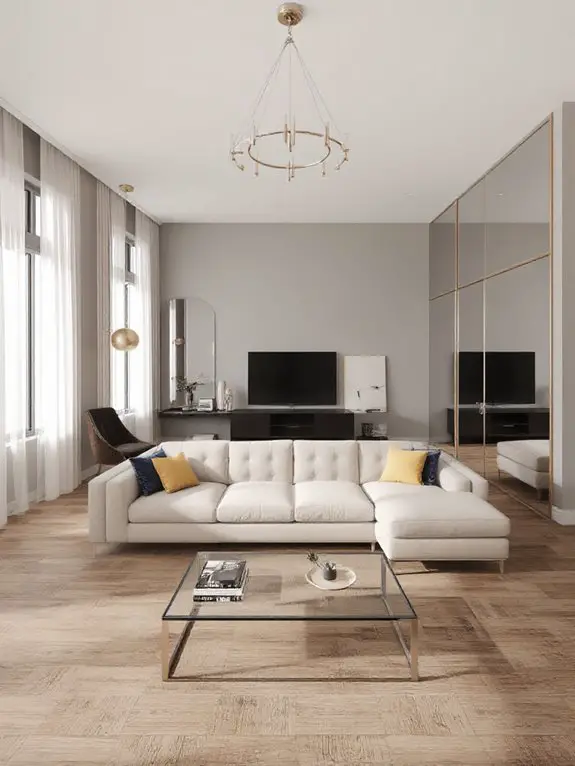
Mirrors can transform the perception of space in a living area with just a few strategic placements. I always recommend positioning a large mirror opposite a window to reflect natural light, making the room feel brighter and more open. Frameless or slim-profile mirrors work well in smaller spaces, as they blend seamlessly into the walls.
Placing mirrors behind or near light sources, like lamps or candles, amplifies their glow, enhancing the ambiance. For a sleek, modern look, I suggest using mirrored furniture or a mirrored accent wall. These techniques not only create depth but also add a touch of elegance to the design.
Layered Rugs for Added Warmth
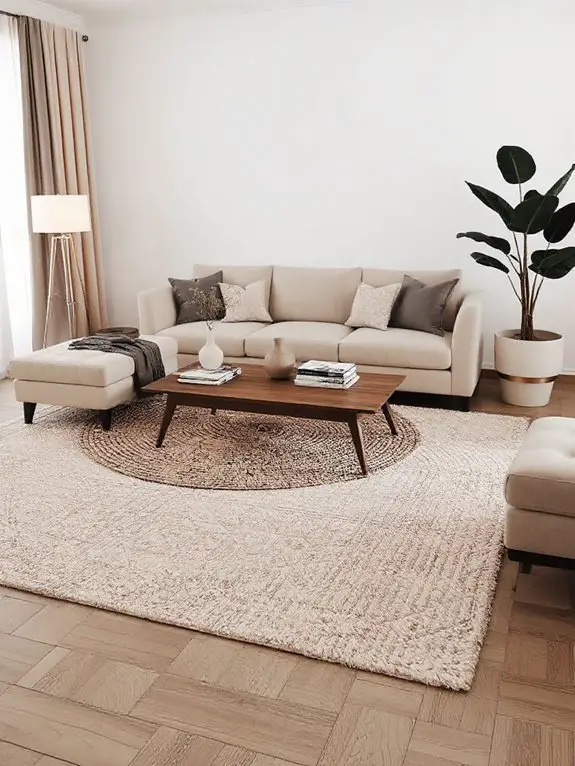
To add warmth and texture to your living area, layering rugs is a simple yet effective technique I often use in my designs. Start with a larger, neutral base rug—like jute or sisal—for durability, then layer a smaller, plush rug on top for contrast.
Mixing patterns or textures, like a geometric wool rug over a flatweave, adds depth. Make sure the top rug anchors your seating area, tying the space together.
This approach not only softens hard floors but also defines zones in open layouts. Just keep proportions balanced; too much overlap can look messy.
Multifunctional Furniture for Flexibility
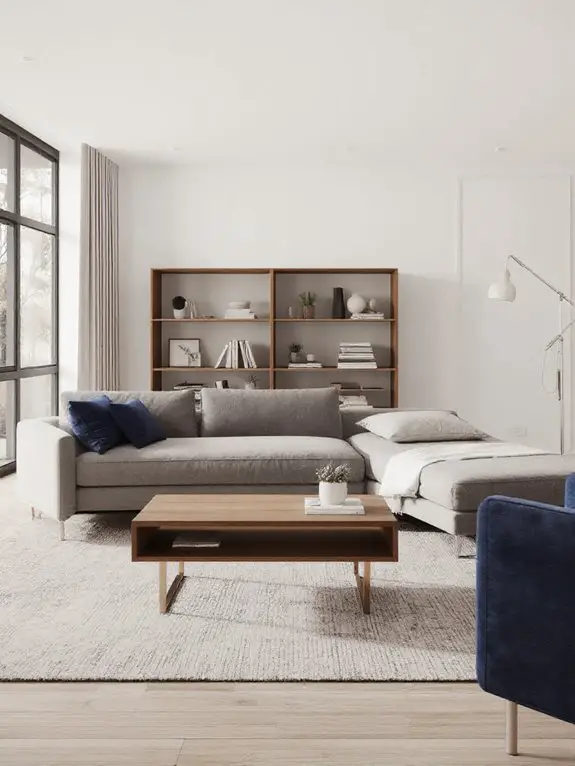
Just as layering rugs maximizes both style and function, choosing furniture that serves multiple purposes can transform how a living space works. I love incorporating pieces like sofa beds or ottomans with hidden storage—they’re perfect for small spaces or when hosting guests.
Nesting tables are another favorite; they’re compact yet expandable for extra surface area. I also recommend modular sectionals that can be rearranged to fit different layouts.
These choices not only save space but also add versatility to your design. By prioritizing multifunctional furniture, I’ve created living areas that are both practical and stylish, adapting effortlessly to daily needs.
Coastal Vibes With Light and Airy Decor
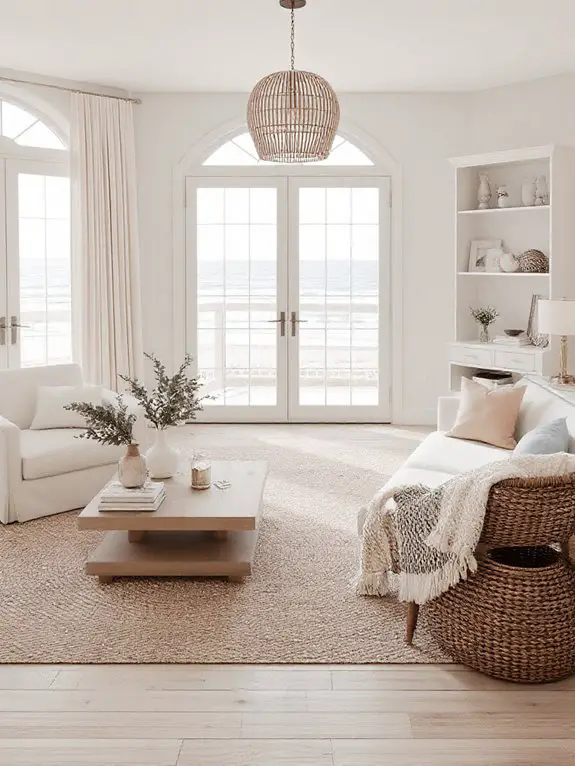
When aiming to bring coastal vibes into your living area, it’s essential to focus on light and airy decor that evokes the serenity of the seaside. Start with a neutral palette—think white, beige, and soft blues—to mimic the sand and ocean.
Incorporate natural materials like rattan, jute, and driftwood for texture and warmth. Sheer curtains or light linen drapes allow sunlight to flood the space, enhancing that breezy feel.
Add subtle nautical touches, such as striped cushions or woven baskets, without overwhelming the theme. Keep furniture low-profile and uncluttered to maintain an open, relaxing atmosphere that invites calm.
Industrial Chic With Exposed Elements
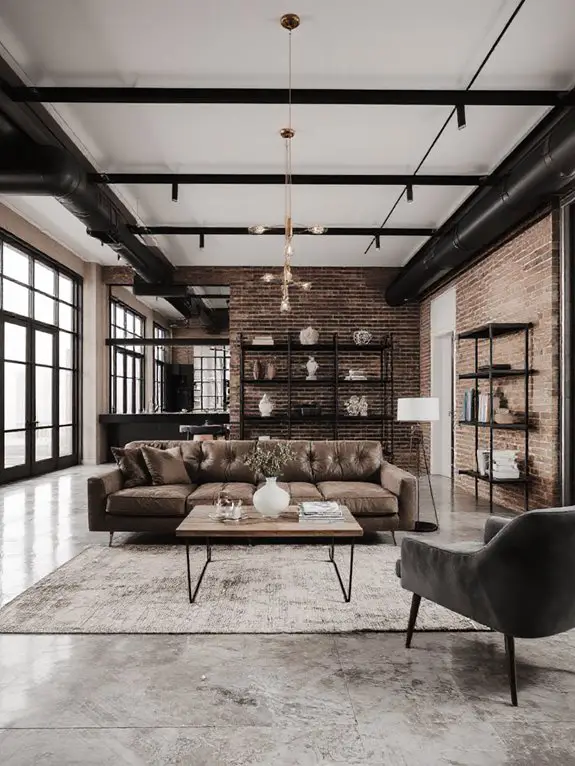
Industrial chic embraces raw, unfinished elements that celebrate the beauty of structure and authenticity. I love incorporating exposed brick walls, steel beams, and concrete floors to create a grounded aesthetic. To soften the hardness, I’ll add warmth with reclaimed wood furniture or leather accents.
Open ceilings with visible ductwork enhance the space’s industrial vibe, while metal lighting fixtures, like pendant lamps or cage sconces, add functional charm. I recommend keeping the color palette neutral—grays, blacks, and whites—to let the textures shine.
It’s a style that feels bold yet approachable, perfect for those who appreciate the elegance of simplicity and the honesty of materials.
Playful Patterns and Prints
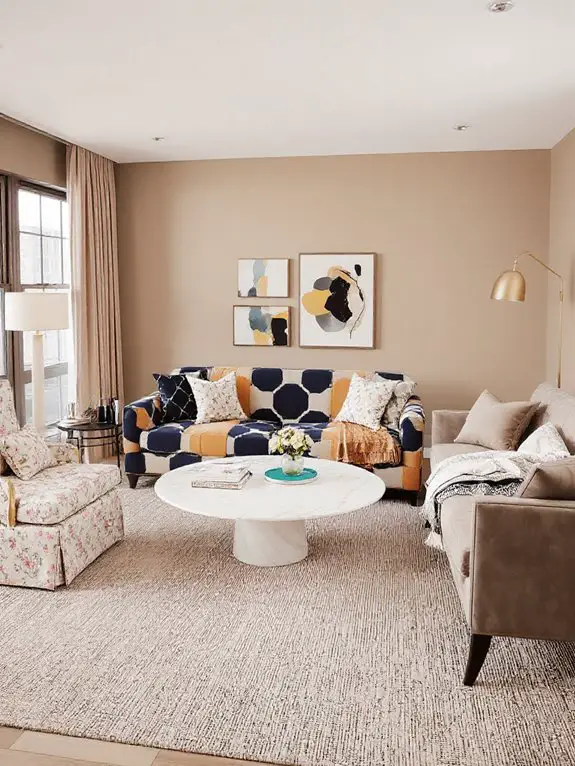
Incorporating playful patterns and prints into your living area can instantly elevate the space with energy and personality. I love mixing bold geometric designs with softer floral motifs to create a dynamic yet balanced look.
Start with a patterned rug or accent chairs to anchor the room, then layer in throw pillows or curtains with complementary prints. Stripes and polka dots can add a touch of whimsy, while animal prints bring a hint of sophistication.
I recommend sticking to a cohesive color palette to avoid overwhelming the space. Don’t be afraid to experiment—patterns can transform your living area into a vibrant, inviting haven.
Dramatic Accent Walls for Depth
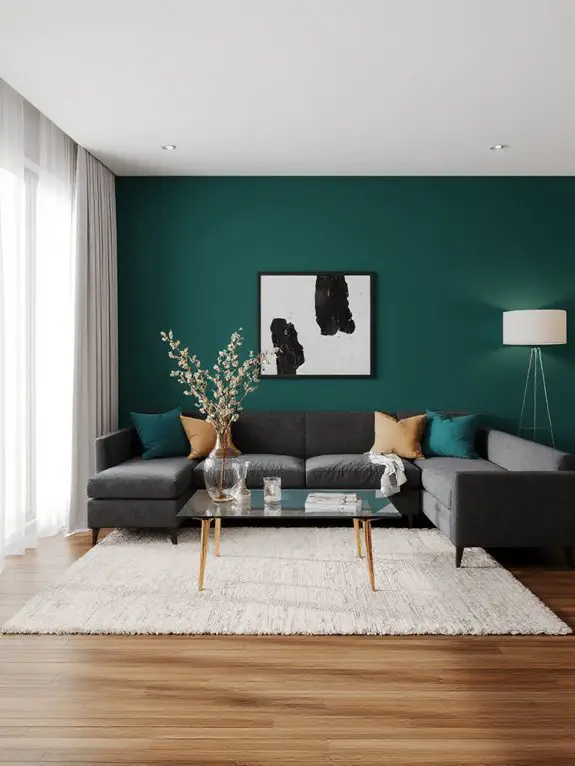
While many focus on furniture and decor, a dramatic accent wall can serve as the centerpiece of your living area, adding depth and intrigue to the space. I recommend choosing a bold color or textured finish to create visual interest.
Dark hues like charcoal or navy add sophistication, while textured materials like wood paneling or exposed brick bring warmth. For a modern touch, consider geometric patterns or metallics.
Guarantee the wall complements your existing palette for cohesion. Lighting is key—spotlights or sconces can highlight its details. An accent wall’s power lies in its ability to transform a room effortlessly.
Smart Storage Solutions for Clutter-Free Spaces
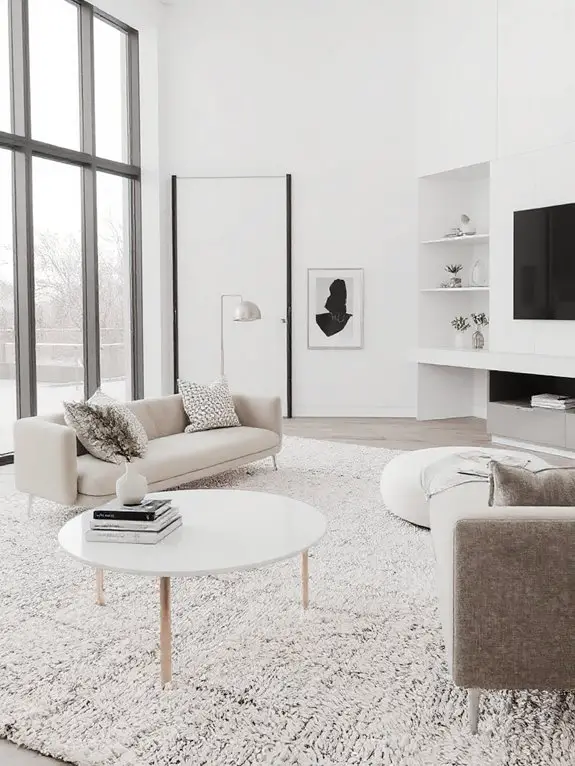
Creating a dramatic accent wall adds character, but maintaining a clutter-free space guarantees the room remains functional and inviting. Start by evaluating your storage needs—think vertical shelving or built-in cabinets to maximize space.
Use multifunctional furniture like ottomans with hidden compartments or coffee tables with drawers. Baskets and decorative bins are perfect for stashing items like blankets or magazines.
I always recommend labeling storage containers to keep things organized. Don’t forget to declutter regularly, keeping only what you need. A tidy living area feels larger and more serene, making it a space you’ll truly enjoy.
Warm Lighting for a Cozy Ambiance
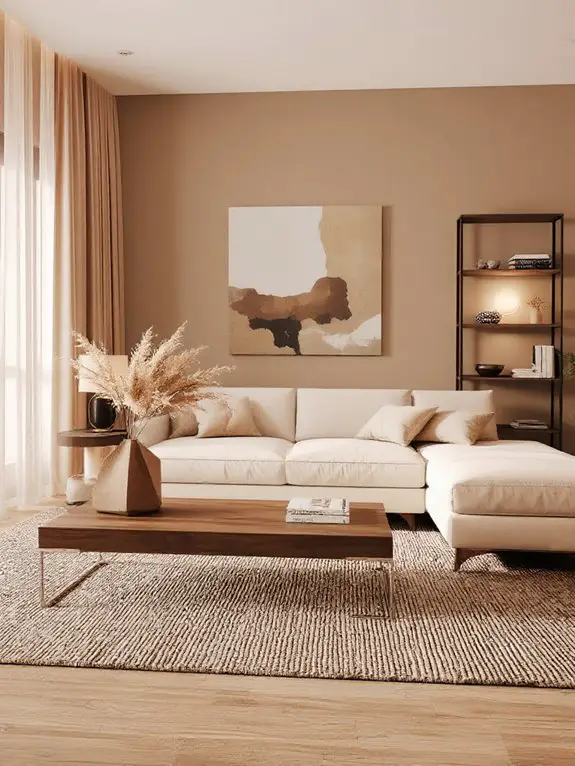
When you’re aiming to make a room feel inviting, warm lighting can transform the atmosphere instantly. I always recommend using soft, amber-toned bulbs instead of harsh, cool ones—around 2700K to 3000K on the color temperature scale.
Table lamps with fabric shades diffuse light beautifully, creating a gentle glow. Dimmer switches are a must-have; they let me adjust the brightness to match the mood, whether it’s for relaxing evenings or lively gatherings.
Candles or LED fairy lights add warmth without overwhelming the space. Positioning lights at different heights—like floor lamps and wall sconces—creates layers of illumination that feel cozy and balanced.
Seasonal Decor Updates for Year-Round Charm
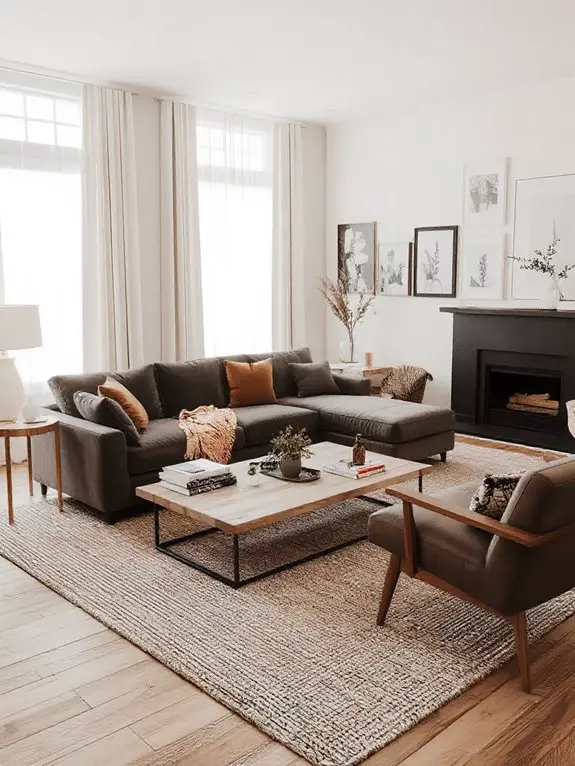
To keep your living space feeling fresh and inviting all year, I focus on simple seasonal decor updates that don’t require a complete overhaul. Start with versatile neutral furniture and layer in seasonal accents like throw pillows, blankets, and area rugs.
In spring, I introduce pastel tones and floral patterns, while summer calls for light linens and coastal-inspired decor. Fall is perfect for rich textures and warm hues, and winter brings cozy knits and metallic touches.
I also swap out artwork, candles, and small decor items to reflect the season. These subtle changes create a dynamic space without overwhelming effort.
Frequently Asked Questions
How Do I Choose the Right Curtains for My Living Room?
I consider the room’s purpose, lighting, and color scheme when choosing curtains. I’ll pick heavier fabrics for privacy or light-filtering ones for brightness. I make sure the length and style complement my furniture and overall vibe.
What’S the Best Way to Arrange Seating for Conversation?
I like to arrange seating in a way that encourages conversation, so I place chairs and sofas facing each other, close enough for easy talking but with space to move. A central focal point helps, like a coffee table or rug.
How Can I Protect My Furniture From Pet Damage?
I’ve found that prevention’s worth a pound of cure when protecting furniture from pets. I use washable slipcovers, pet-friendly fabrics, and deterrent sprays. I also train my pets and keep their nails trimmed to minimize scratches.
What’S the Ideal Height for Hanging Wall Art?
I’d suggest hanging wall art at eye level, typically around 57 to 60 inches from the floor to the center of the piece. It guarantees it’s easily visible and creates balance in the room without feeling too high or low.
How Do I Clean and Maintain Velvet Upholstery?
Did you know 60% of velvet furniture stains come from spills? I vacuum my velvet upholstery weekly to prevent dust buildup and use a soft brush to restore its plush texture. For stains, I blot gently with water and mild soap, then air dry.

